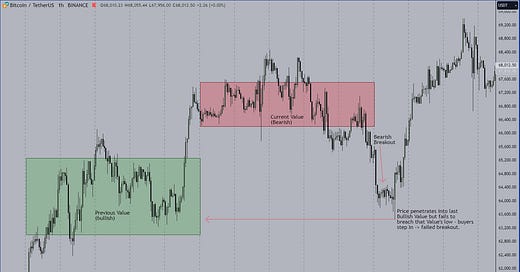In this post I will discuss the strategy I use for trading BTC. It’s no secret that when it comes to short to midterm trading crypto, I am rather a novice and the strategy itself is still undergoing some minor modifications.
In my recent trades, one thing has appeared that I really dislike in speculation: false breakouts. Since the strategy is roughly more trend-following than not, this risk is always present. However, the way BTC handled my two positions was too obvious. By this, I mean too obvious traps that are usually visible at first glance, and it is easy to introduce some improvements to the strategy to prevent this.
For those users who utilize my material on emini.today about BTC trading, they should read the next part carefully.
Chasing Value.
When it comes to profiling BTC, nothing changes here. I still believe it is a market with very good auction characteristics, making it easy to identify value dynamics. However, what I didn’t appreciate or perhaps overlooked was the behavior of market participants when escaping the current value zone.
Let’s assume we identify a forming new value area in an uptrend. After a few sessions, there is an attack by sellers leading to a breakout beyond the current value zone. In most situations, correctly identifying such a breakout allows for taking a position aligned with the momentum and determining a key resistance that theoretically should be defended by bears taking the initiative.
The whole problem, however, is that we forget about the buyers, who certainly haven’t disappeared. During a bearish breakout, our reference point should always be the previous bull value zone. And now the most important part: how can we "easily" determine if we are dealing with a false breakout?
If the price during the breakout dives into the last bull value area but cannot breach its value low, we are dealing with a false breakout. On the other hand, if during the breakout the price falls but doesn’t even reach the area of the last bull value area, then we know that the breakout has plenty of room and the price will continue to fall until it tests this zone.
Of course, the third option is that the breakout breaches the value area low, and then we are dealing with a true bearish breakout.
In light of what I wrote above, we must acknowledge that the bearish breakout was unsuccessful, and long positions are still justified. Personally, I closed my short position and, with a small long position, I am waiting for the next setup. This time, I do so with an awareness of the relationship between bullish and bearish value zones simultaneously.
(If you are emini.today BTC discord member and not sure about any of the things I discussed above, please dm me on our discord channel).
Notes/Observations/Issues:
Value analysis is divided on three parts which make three separate strategies.
Trend - midterm timeframe, following values as they build.
Market Condition - analysing value from overbought/oversold pov. Countertrend trades. Can be used to reduce Trend positions.
Key Resistance/Support - can be utilized in high leverage short-term trades, but also as good “add to Trend” locations.
Pre-Open Commentary distills key takeaways from the analysis of the London GEX and Structure posts and also serves as my personal journal (sort of).



